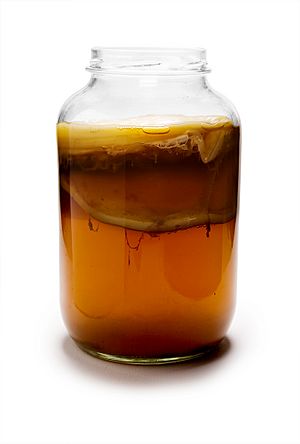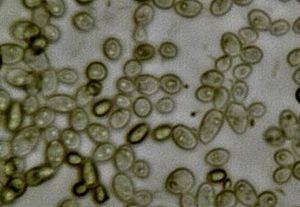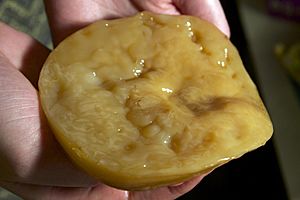Kombucha facts for kids

Kombucha tea, including the culture of bacteria and yeast, which is not usually consumed
|
|
| Type | Flavored cold tea drink with fermentation byproducts |
|---|---|
| Country of origin | China |
| Alcohol by volume | <0.5% (commercial) |
| Proof (US) | <1 (commercial) |
| Color | Cloudy, commonly pale or dark brown and sometimes green |
| Flavor | Fermented, effervescent |
| Ingredients | Tea, sugar, bacteria, yeast |
| Variants | Fruit juices or spices added |
| Related products | Water kefir, Kefir, Kvass, Beer, Iced tea |
Kombucha is a slightly fizzy, sweetened tea drink. It is made through a special process called fermentation. People often drink it because they believe it has health benefits.
Sometimes, people call it "kombucha tea." This helps to tell it apart from the special mix of bacteria and yeast used to make it. You can often find kombucha with added fruit juice, spices, or other flavors.
Kombucha likely started in China, where it has been a traditional drink for a long time. By the early 1900s, it had spread to Russia. From there, it moved into other parts of Eastern Europe and Germany. Today, people make kombucha at home all over the world. It is also bottled and sold in stores. The global market for kombucha was worth about $1.7 billion in 2019.
Kombucha is made by fermenting sweetened tea. This uses a special group of living things called a "symbiotic culture of bacteria and yeast," or SCOBY. People often call the SCOBY a "mother" or "mushroom." The tiny living things in a SCOBY can be different. The yeast usually includes Saccharomyces cerevisiae. The bacteria almost always include Gluconacetobacter xylinus. These bacteria change the alcohol made by the yeast into acetic acid (which is like vinegar). Even though it's called a "tea fungus" or "mushroom," a SCOBY is actually a mix of bacteria and yeast living together. These living bacteria are thought to be probiotic, which is one reason the drink is popular.
Many people claim that drinking kombucha is good for your health. However, there is not much scientific proof to support these claims. The drink has rarely caused serious problems. These problems might happen if it gets dirty during home preparation. It is not suggested for medical treatment.
Contents
The History of Kombucha
Kombucha probably began in the Bohai Sea area of China. The drink became popular in Russia and then spread to other parts of Europe. In the United States, more people started drinking it in the early 2000s. Kombucha usually has less than 0.5% alcohol. This means it is not regulated as an alcoholic drink in the U.S.
Before 2015, some store-bought kombucha had more alcohol than allowed. This led to new ways of testing the drink. As kombucha became more popular in developed countries, its sales grew. It was marketed as a different choice from beer and other alcoholic drinks in restaurants and pubs.
According to Grand View Research, the global kombucha market was worth about $1.67 billion in 2019. It was expected to grow to $2.4 billion by 2027.
What's in a Name?
In Japanese, the word konbu-cha or kobu-cha (昆布茶, 'kelp tea') means a tea made from powdered konbu. Konbu is an edible seaweed. This kelp tea is completely different from the fermented tea we call kombucha.
The exact origin of the name kombucha is not clear. But it is thought to be a Japanese word that was used incorrectly in English. Some believe English speakers mistakenly thought the Japanese word kombucha meant fermented tea. In Japanese, fermented tea is actually called kōcha kinoko (紅茶キノコ, 'red tea mushroom').
Webster's Dictionary says that the English use of kombucha likely came from a mistake. It might have mixed up the Japanese words for 'tea made from kelp' (kombucha, kobucha), 'kelp' (kobu, konbu), and 'tea' (cha). The American Heritage Dictionary adds that it was "perhaps... used by English speakers to designate fermented tea due to confusion or because the thick gelatinous film produced by the kombucha culture was thought to resemble seaweed."
The first time the word kombucha was used in English to describe this fermented drink was in 1944. It referred to the "gelatinous mass of symbiotic bacteria... and yeasts... grown to produce a fermented beverage held to confer health benefits."
How Kombucha is Made
Kombucha can be made at home or in factories. It starts by dissolving sugar in hot, non-chlorinated water. Tea leaves are steeped in this sweet water, then removed. The sweetened tea is cooled. Then, the SCOBY culture is added.
The mixture is poured into a clean container. A small amount of already fermented kombucha tea is also added. This helps to lower the pH, making it more acidic. This method is called "backslopping." The container is covered with a paper towel or cloth. This stops insects like fruit flies from getting in.
The tea ferments for about 10 to 14 days at room temperature (18°C to 26°C). A new "daughter" SCOBY will grow on top of the tea. After fermentation, the SCOBY is taken out. It is stored with a little bit of the new tea. The rest of the kombucha is strained and bottled. It can be fermented again for a few days to add more fizz. Or, it can be stored in the fridge at 4°C.
Store-bought kombucha became available in the late 1990s. In 2010, some bottled kombucha had higher alcohol levels than allowed. This caused stores like Whole Foods to temporarily remove them from shelves. In response, kombucha makers changed their recipes to have lower alcohol levels.
By 2014, sales of bottled kombucha in the U.S. were $400 million. Most of this was from Millennium Products, Inc., which sells GT's Kombucha. In 2014, companies that make kombucha formed a group called Kombucha Brewers International. In 2016, PepsiCo bought a kombucha company called KeVita for about $200 million. In the U.S., sales of kombucha and other fermented drinks grew by 37 percent in 2017. Even beer companies like Full Sail Brewing Company and Molson Coors Beverage Company now make kombucha.
As of 2021, kombucha was also gaining popularity in India's National Capital Region. This was partly due to its success in Western countries. Indian kombucha brands include Bhu Kombucha, Stoked Kombucha, and Toyo Kombucha.
Hard Kombucha
Since 2019, some companies sell "hard kombucha." This type has a higher alcohol content, usually over 5 percent.
Other Uses for Kombucha Culture
When a kombucha culture (SCOBY) is dried, it turns into a material like leather. This material is called microbial cellulose. It can be shaped to create seamless clothing. Different liquids used to grow the kombucha culture, like coffee or green tea, can make different colors of textile. The material can also be dyed using plant-based colors. Different growing liquids and dyes also change how the textile feels. The SCOBY itself can also be dried and eaten as a sweet or savory snack.
See also
 In Spanish: Kombucha para niños
In Spanish: Kombucha para niños




